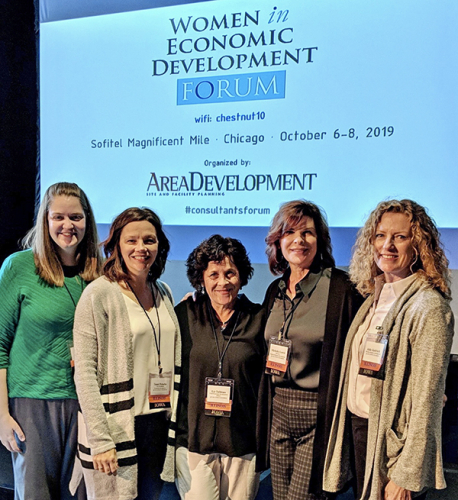Chamber’s new approach to economic development ‘validated’ at national conference

Upon return from the recent Women in Economic Development Forum in Chicago, the Chamber’s longtime Chief Economic Development Officer Liz Murray Tallman declared it the best conference she’s ever attended.
“It really validated everything we are trying to accomplish,” said Murray Tallman, who oversees Quad Cities First, the economic development division of the Chamber. “It’s also encouraging to see women wanting to help each other learn and grow in a competitive and historically male-dominated field.”
Murray Tallman and the predominantly female team she’s built are sidelining traditional economic development strategies and implementing a next-generation, data-driven approach to business growth, retention and attraction in the Quad Cities region.
Business growth, retention
Experts at the national conference affirmed the Economic Development team’s enhanced focus on research and analysis of the industries and companies driving the regional economy as well as those that are emerging and struggling.
Using data, the team recently analyzed each of the Chamber’s five target industries and associated companies to learn which ones have grown and declined over the past 10 years. Currently the Chamber’s five target industries are: Advanced Manufacturing, Agricultural Innovation, Corporate Operations and Services, Logistics and Defense.
“For the industries driving our economic base and growing, we need to make them a priority in helping them stay and grow,” said Julie Jindrich, Director of Business Intelligence. “For the industries driving our economic base and declining, we need to better understand why this is happening and learn if there are actions we can take to ensure they stay in our region and ultimately grow.”
“The data tells us what is happening, but the face-to-face conversations our team has with industry representatives gives us even greater insight as to why growth or decline is happening,” Jindrich said.
Michelle Lewis, who manages the business expansion and retention program, meets with about 150 companies a year and provides technical assistance to help them grow. As a former owner of a manufacturing company, she brings “street cred” when meeting with companies, Murray Tallman said.
Business attraction
Another big change to the Economic Development program is its approach to traditional interactions. Previously the team required a “road warrior,” someone who spent the majority of their time traveling to attend trade shows and forums.
Because of its focus on targeted, data-driven decisions, the program now relies on the Chamber’s new website – its “front door” to the region – to make the first point of contact with the outside world. Using data analytics, the team can track and better engage website visitors.
In addition, Tami Petsche, Vice President of Economic Development, oversees the business attraction program and travels about 20-25% of the time. She forms strategic relationships with site selectors and candidates for relocation to the Quad Cities region.
The Chamber also can use multiple sources of data, including utilities, taxes and wages, to illustrate how the total cost of doing business here is lower than other regions and states, Jindrich said.
Keeping up with the trends
While Petsche is confident they are on the right track and doing the right things with their new data-driven efforts, the national conference encouraged the team to consider how to:
• Better target and attract food/beverage and e-commerce industries
• Help existing food/beverage companies in the Quad Cities grow
• Work with cities to offer creative and flexible incentives for development projects
Petsche also identified the following ways to improve the region’s chances of closing a deal when a company initially shows interest in locating here:
• Having an organized and timely permitting process
• Showcasing positive testimonials from existing companies
• Being flexible and having multiple plans for unexpected site visits
“These are all things we can do before a company enters our community to show them we are a great place to do business,” Petsche said.




